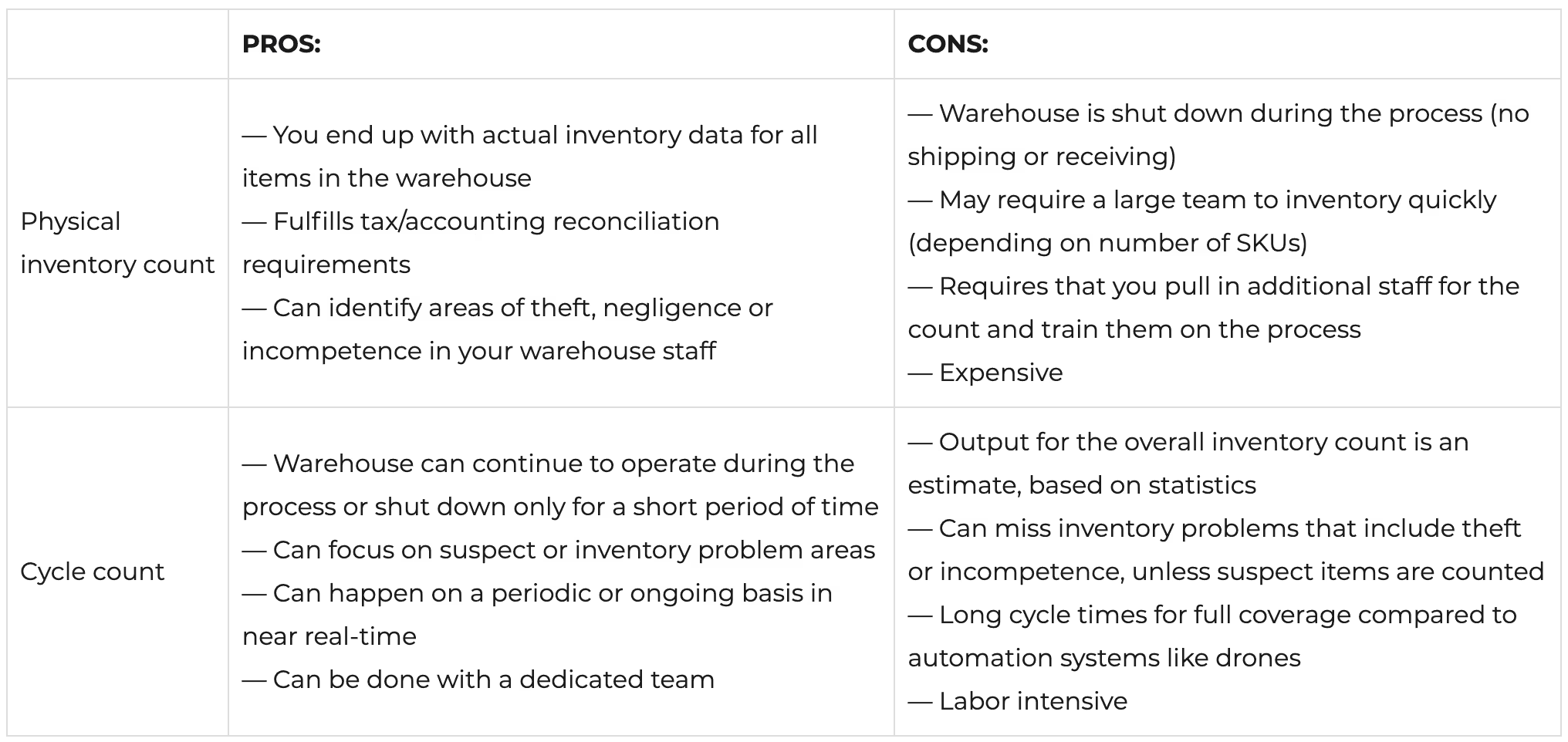What Is Warehouse Inventory Counting?

Let's start by first answering the question: What is warehouse inventory counting?
Inventory counting is a process for validating and reconciling the amount of inventory that you have in your warehouse at any given time. Having the correct inventory count is critical to customer satisfaction in addition to all the financial implications of holding too much inventory or not turning inventory fast enough. Those are three KPI's that I am sure you are familiar with.
There are two generally accepted methods for inventory counting:
- Physical inventory count - a systematic, physical inventory counting process
- Cycle count - a sampled inventory process that uses statistical methods to predict actual inventory levels
Both of these methods have pros and cons that enable a warehouse manager to determine which method is the best fit for a given facility at a given point in time. A physical inventory process requires that you shut down the warehouse and physically go through and systematically count all of the items stored in the warehouse. Physical inventory counts might be needed at least once a year, for tax and end-of-year accounting purposes. Alternatively, a cycle count method enables you to count a smaller subset of items within the warehouse without needing to shut down the warehouse and count everything. Cycle counting uses statistical methods to determine the overall inventory accuracy through the sampling of a smaller set of items.
PROS and CONS For Inventory Counting Methods

Cycle Count As A Best Practice
In a large warehouse, a physical inventory count can be time consuming, and the time that it takes to perform a complete physical inventory may take the warehouse out of production for too long. If you can't afford the downtime for a physical count, cycle counting might be the best solution. A cycle count can be performed more frequently and without negatively impacting warehouse operations.
There are a variety of different cycle count methods. The goal of each cycle count method is to count a subset of "things" and then extrapolate the results to the broader inventory pool. One method focuses on counting high-value inventory SKUs, while another method targets high-turnover SKUs. There are also a variety of hybrid cycle counting methods that use a combination of counting strategies. At the end of day, a cycle count attempts to first validate the accuracy of your warehouse management system of record. It subsequently updates the inventory estimates of items not counted using the inventory trends identified by the items that were counted.
As warehouses become more automated, there are new opportunities to automate the cycle counting process. If you deploy a goods-to-person automation process, then some form of automation (mobile robot or automated storage and retrieval) will acquire and bring totes/bins/boxes of SKUs out of storage to a singulation point. As individual items are picked for shipment, the storage unit can be tagged for an in-process cycle count before it is returned to the storage location. This is just one example of how warehouse automation is evolving to help improve the fulfillment process.
Once you implement cycle counting, you will also want to rotate the target items that are being counted. A common best practice is to ensure that every SKU is cycle counted at least once per quarter. This includes overstock items and reserve locations. Worst case, you might have a large, multi-level warehouse where items can carelessly get misplaced. This can lead to apparent stockouts, that directly impact your business and which might be easily preventable.
The Gather AI Solution
Our customers use the Gather AI solution to monitor their inventory. Drones fly through their warehouses taking pictures of pallet locations. The pictures are uploaded to the cloud where they are analyzed and compared with what’s stored in the customer’s warehouse management system (WMS). The solution is 15 times faster than traditional cycle counting. Faster cycle counts mean that inventory errors can be found and fixed more quickly,
Conclusion
Every warehouse manager understands the business value of accurate inventory counts. Every warehouse manager also feels the pain that it takes to maintain accurate inventory and the operational disruption to perform an inventory count. Talk to Gather AI about how we can help.
Transform your warehouse.
No infrastructure changes necessary





.webp)